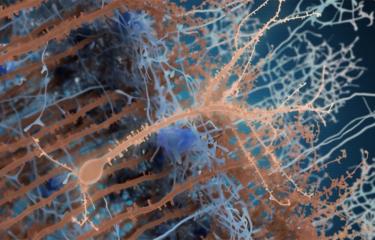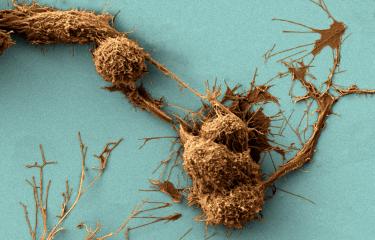In the brain, sensory messages are processed by neurons that send the information collected by the sensory organ to the different structures of the brain. At each stage of integration, the activity of these neurons is controlled by interneurons that exert local inhibition in order to direct and modulate the neural messages. This type of circuit forms the classical architecture of the sensory brain systems in vertebrates. A team of researchers from the Institut Pasteur, the CNRS, and Université Paris Cité revealed the existence, in an animal model, of inhibitory neurons that establish connections from a distance, taking the reverse path from so-called "higher" brain structures to the olfactory bulb. This new retroactive inhibitory circuit is essential for fine processing of sensory information. These findings were published in Nature Communications on November 12, 2022.
In the olfactory system, the sensory organ of smell, which is located at the top of the nasal cavity, transforms the presence of odorous compounds into electrical signals. These signals are then transmitted to the olfactory bulb, the first relay in sensory processing. The olfactory bulb processes the signal by reducing the amount of information to be communicated to the brain, in order to minimize "background noise." Once encoded and processed, these signals are transmitted to the cortex, the site of stimulus identification and olfactory memory. In general, the activity of excitatory neurons capable of making long-distance connections in the brain is under the close control of interneurons that exercise local inhibition to moderate the nervous message and thus prevent a surge in overall brain activity.
With the aim of characterizing these local inhibitory neurons, researchers from the Institut Pasteur, the CNRS and Université Paris Cité have discovered, in a mouse model, the existence of neurons capable of establishing long-distance connections from the cortex to the olfactory bulb. The scientists positioned a fluorescent marker specific to inhibitory neurons in the olfactory bulb, and were surprised to find that this marker traced back to so-called "higher" structures. The marker is found in neuronal cells located in the olfactory cortex (see microscopy image above). The scientists have thus discovered a new retroactive control pathway linking the cortex directly to the olfactory bulb.
In principle, these long-range inhibitory neurons could have powerful effects on sensory processing since they contact all the various types of neurons in the olfactory bulb. This is what the specific stimulation of these inhibitory neurons demonstrates. Coupled with cellular imaging, this stimulation causes an overall reduction in the activity of the olfactory bulb neurons. Moreover, the stimulation of these inhibitory neurons makes the olfactory responses of the olfactory bulb neurons more selective. In short, with fewer active neurons an individual's perception is improved. Indeed, neuroscientists have shown that the activity of inhibitory neurons in the cortex is essential to distinguish between similar-smelling compounds, such as water mint and peppermint.
The perception of odors is constantly being guided and shaped by our olfactory memory, and our past experience helps us to perceive and recognize an odor. This link between memory and perception enhances our ability to detect an odor that is part of a mixture as well as allowing us to better identify and discriminate between one odor and another. The researchers show in this study that the adjustment of sensory processing is based in part on inhibitory feedback from the olfactory cortex, or memory center, to the olfactory bulb.
"The nature of these inhibitory signals and the context in which they are sent from the memory center to the perception center remain unknown. One theory is that this pathway would increase the focus on an odor to ensure better recognition", explains Gabriel Lepousez, a scientist in the Perception and Memory Unit (Institut Pasteur/CNRS[1]) at the Institut Pasteur and joint last author of the study. "This type of inhibitory circuit, which has just been identified for the first time in the olfactory system of a vertebrate, could be present in other sensory systems", he adds. Thus, cortical inhibitory feedback would represent a new type of neural circuit that refines sensory perception in general. "By improving our understanding of the mechanisms of perception, these results open up interesting perspectives on olfactory conditioning but also on pathological disorders of perception", he concludes.
Source
Long-range GABAergic projections contribute to cortical feedback control of sensory processing, Nature Communications, 12 novembre 2022.
Camille Mazo1,2,*, Antoine Nissant1, Soham Saha1, Enzo Peroni1, Pierre-Marie Lledo1,* and Gabriel Lepousez1,*
1 Institut Pasteur, Université Paris Cité, Centre National de la Recherche Scientifique, Unité Mixte de Recherche 3571, Perception and Memory Unit, F-75015 Paris, France
2 Current address at Champalimaud Research, Champalimaud Center for the Unknown, Lisbon, Portugal
* Corresponding authors






